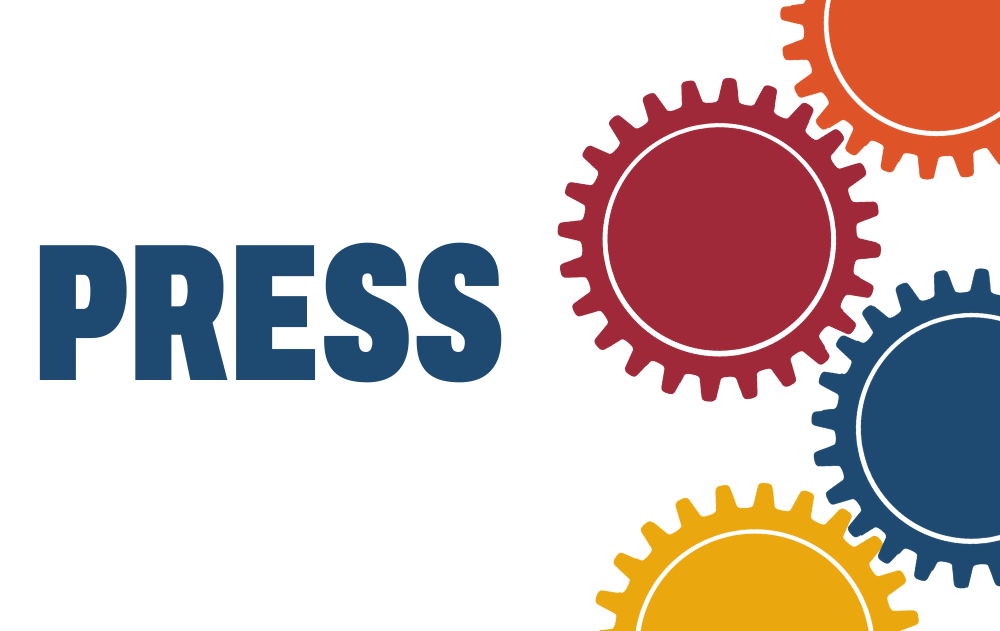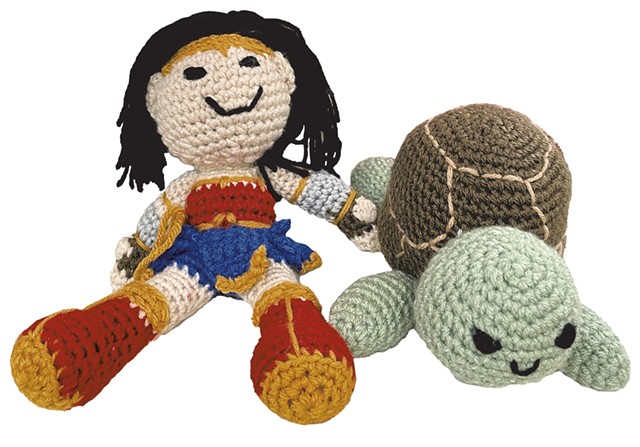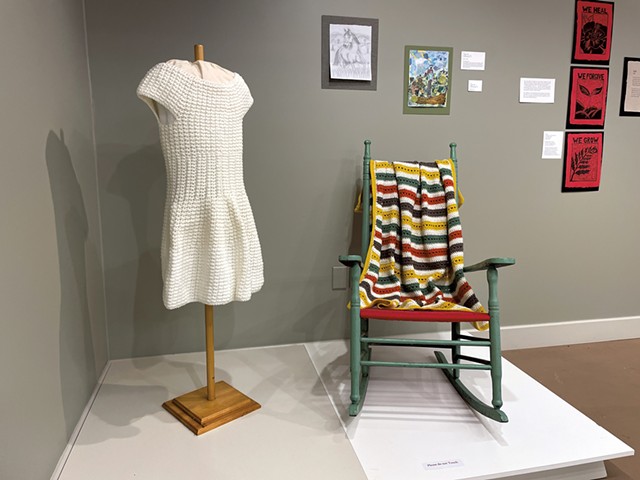New Rokeby Exhibit Showcases Works by Imprisoned Artists

This article was initially published by Seven Days on August 23, 2023. A new exhibit opened at the Rokeby Museum in Ferrisburgh- Finding Hope Within: Healing & Transformation through the Making of Art within the Carceral System. The art on display was created by individuals who are incarcerated in Maine, Massachusetts, and Vermont – including some pieces from artists who VWW has worked with through our justice-involved services at Chittenden Regional Correctional Facility.
Seven Days | August 23, 2023
By Mary Ann Lickteig
The 11-by-17-inch drawing of brightly colored potted flowers and greenery is crinkled and shiny. The museum label displayed below says the work, which is untitled, was created in 2021 with torn brown paper bag, colored pencil and prison floor wax.
“I know this looks rough,” the artist’s statement says. “But I don’t have things to make it perfect. I hope you see the effort I put into this. I tried very hard with what I have.” The statement is signed, but Maine State Prison, where the artist resides, did not allow inclusion of his last name. In this show at Rokeby Museum in Ferrisburgh, he is “Russ #46863,” his inmate number.
“Finding Hope Within: Healing & Transformation Through the Making of Art Within the Carceral System” opened on August 10 and runs through October 14. It displays nearly 50 items — drawings, painting, sculpture, fiber art, poetry and other writing — created by people imprisoned in Vermont, Massachusetts and Maine.
The artists are identified in various ways — by initials, their first name or, in a couple of instances, their full name. Some works list no name at all. “That decision is made by each state’s department of corrections,” the exhibit statement says. “You will notice that the availability of standard art supplies will vary between the three neighboring states; even within the same prison,” the statement continues. “A careful reading of the gallery labels will inform you as to the creativity and innovation of the artists.”
Edward Andrew Knight did not have access to tape, glue or scissors inside a maximum-security prison in Massachusetts. To create “Birds on a String,” a 36-inch-tall mobile, as a gift for attorney Laura Carey of the New England Innocence Project, he used Q-tips, paper, Band-Aids and bedsheet threads. Delicate origami owls and cranes — seven in all, because that’s a lucky number, Knight noted — balance gracefully, displayed with a detailed diagram that includes Knight’s comments, doodles and notes to himself.
Those read, in part: “use envelope seal part to glue things … contain Irish Blessing written and hidden within … Need to pack it in a way that its not only easy to take out, but can be a 1-2-3 step process to set up. cant get tangles or knots!! [sad face] it might end up looking cheep!?? Hmm May find stupid/corny.”
At the bottom of the second sheet of his notes, above an intricate ink drawing of barbed wire, Knight wrote, “Make positive time behind the barb wire.”

“Wonder Woman and Friend,” crocheted by E.D. at Chittenden Regional Correctional Facility. Source: Mary Ann Lickteig
John Vincent, creator of the New Haven-based nonprofit A Revolutionary Press, pulled the exhibit together quickly after he learned in June that Rokeby Museum had postponed a show, leaving gallery space empty for the last two and a half months of its season. Vincent works with artists who teach in Maine prisons, and he knew that art created there had been exhibited publicly, he said. “I thought that Vermont should have that.”
Rokeby executive director Lindsay Varner agreed. The show fits the museum’s mission, she said. The National Historic Landmark, part of the Underground Railroad, was home to four generations of the Robinson family, “who wanted people to learn more about what was happening in the world around them,” Varner said. In addition to abolition and agriculture, Rokeby focuses on art and advocacy. Rowland T. Robinson, Varner noted, was a 19th-century Vermont legislator who pushed for an end to capital punishment.
Vincent relied on groups working in prisons — including Vermont Works for Women and Women’s Justice & Freedom Initiative — to gather submissions for the exhibit. “I literally put everything I got on the wall,” he said. “And when you step back and look at it, you go, Well, this isn’t about just making pretty pictures and saying nice things. This is about someone who’s trying to create expressively what they’re feeling inside. And moving beyond that worst thing.”
“There’s a phrase,” he continued: “‘You can lock up the person, but you can’t lock up their spirit.’ And this is about their spirit trying to come through. And, ultimately, it seems to be about healing.”
The Vermont submissions all came from the state’s women’s prison, Chittenden Regional Correctional Facility in South Burlington. Most were created early in the pandemic in response to the prompt “What does healing mean to me?”
One woman used colored pencils to draw a smiling crescent moon gazing toward a vibrant sun amid swirls, stars and flourishes. J.M. depicted a needle and thread stitching two halves of a heart together. K.B. used paper and pencil to write “Undefeated” amid dandelion fluff floating upward into the air.

Wedding dress and blanket crocheted by C.G. at Chittenden Regional Correctional Facility. Source: Mary Ann Lickteig
Also on display is the wedding dress that C.G. crocheted for her daughter, who also was imprisoned at Chittenden Regional Correctional Facility, and a pencil drawing that C.C. created this summer. “So my drawing is a horse, running in the meadow or fields and mountain tops of Vermont,” C.C. wrote. “I drew it in jail because I miss my barrel horse, Rico, and I had my life taken from me because of the crimes I did. But this is what sets me free is horses I draw in here.”
Additional artists in all three states want to add their work to the exhibit, Vincent said, and he will take it all, “as long as I can get it into the door.”
Heather Newcomb, a Vermont Works for Women program manager who works in the South Burlington prison, sees the joy that art brings to the women who create it. Often they make something as a gift for someone else, “and it just fills their hearts,” she said.
Vincent, a former police officer, wants viewers to see the art, to recognize that human beings made it and to start conversations about a system he considers broken. The U.S. criminal justice system dehumanizes everyone in it, he said, including prison staff and law enforcement officials. According to Prison Policy Initiative, the United States locks up more people per capita than any other nation, Black and Native American people are disproportionately represented in prison, and incarceration costs taxpayers nearly $85 billion a year. The prison population at the end of 2021 was 1.2 million, according to the U.S. Department of Justice.
“No one in this country can say, ‘I am not affected by mass incarceration,'” Vincent said. “We are all affected by it. I believe we’re all traumatized from the fact that we allow a system where we put that many people in prison and keep them there for so long. And then allow them to leave, 95 percent of them, with the understanding that 60 percent are going to go back.”
Art, he said, can help prisoners heal from trauma they have suffered and recognize the trauma they have caused others. Most people in prison will be released at some point, he said, adding, “Who would we want as our neighbor: someone who has been further brutalized by a system or someone who is writing haikus and painting art?”